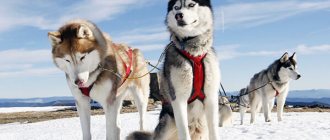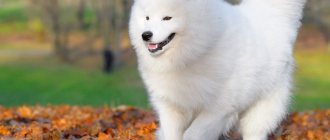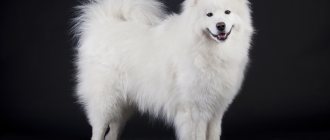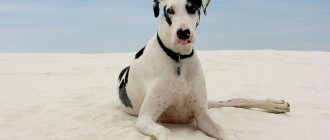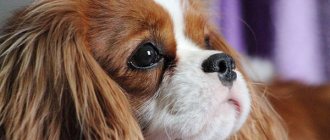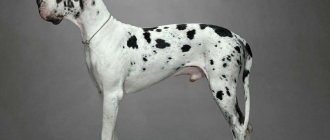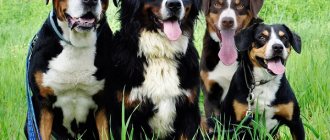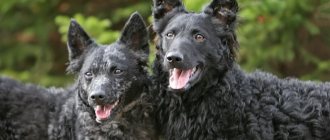Is the Samoyed suitable for keeping in an apartment or on the street?
The Samoyed is a breed suitable for keeping both in an apartment and on the street.
On the one hand, this is an Arctic dog that loves the cold. She copes well outside even in severe frost. All she needs is a sturdy, unheated booth. In addition, the dog loves activity and needs physical activity, and this image fully satisfies these needs.
On the other hand, the Samoyed is very attached to its owner and family members. Therefore, he must have access to the house.
Character
Samoyed dogs are very friendly and sociable. They are used to living among people and do not tolerate loneliness very well. They need a lot of attention, care and love. Animals of this breed very quickly get used to all conditions, they instantly adapt to everything.
Samoyed dogs lack hunting instincts, so they get along well with other animals. There is not a drop of aggression in them and they get along well with children. Many people believe that this is a traditional family dog, and in this they are not mistaken. In every family where a Samoyed lives, peace, prosperity and joy reign.
After talking with a Samoyed, a person receives peace and lightness, especially if the person is depressed. This is such a “fluffy antidepressant”.
Photos of Samoyed dogs always take prizes at exhibitions and competitions, because these animals are incredibly beautiful and harmonious
And the animal that takes part in dog shows is given special attention, because it is very rare to see a Samoyed live
Apartment rules
If your pet lives in an apartment, follow these recommendations:
- The dog must have its own place; teach it to sleep there.
- Brush your pet at least 3 times a week.
- After walks, be sure to wash your dog's paws.
- From an early age, do not allow your dog to chew things and scratch furniture, otherwise this will later turn into a problem.
- Regularly clean your pet's ears and teeth, and trim his nails.
- Under no circumstances should you allow your dog to sleep on your bed.
- If your pet comes back from a walk dirty, give it a bath.
- In an apartment, the dog lacks space and exercise. Therefore, you need to walk your pet a lot, and it must move actively.
- Feed the Samoyed 15–20 minutes after a walk, so the food will be better absorbed.
Personal place
A dog’s personal place is its territory, a cozy corner in which it can relax.
To make your pet comfortable, follow these rules:
- The dog's place should be bright, warm and cozy. Under no circumstances should it be in a draft or passageway.
- Also, do not place it near radiators, heating devices, or in the bathroom.
- The best place for a dog is the entrance to the owner's bedroom or the bedroom itself. This place smells like the owner, his things are here, and for the dog this is the most important thing.
How and what to feed?
Starting at 7 months of age, the Samoyed is fed twice a day. In this case, the dog must be provided with free access to clean water. If you prefer dry food, it is better to choose premium or super premium food.
Premium food includes:
Super premium food:
- Pedigree Advance.
- Purina Pro Plan.
- Eukanuba.
If you are a supporter of natural nutrition, then your dog’s menu should include:
- Lean meat (beef, poultry, rabbit or horse meat).
- Fermented milk products (kefir, cottage cheese, yogurt).
- Sea fish.
- Vegetables (cabbage, carrots, beets, pumpkin, cucumbers, etc.)
- Eggs.
- By-products (kidneys, lung, heart, etc.).
An adult dog should be fed at the same time 2 times a day.
Nutrition
Before feeding Samoyed puppies yourself, as soon as they have crossed the threshold of a new home, you should get detailed advice from the breeder. Even at the time of purchasing a puppy, the breeder must provide complete information about the rules of feeding and diet of dogs.
Firstly, you should stick to the type of food that the puppy received in the kennel, and only gradually switch to another type of food. It is preferable to feed Samoyeds with specially developed food - wet or dry, each owner decides independently.
Secondly, before feeding your Samoyed husky with raw meat and sea fish as an additional type of food, you should first consult with the breeder about the amount of complementary foods, and then with a veterinarian.
Thirdly, what to feed a Samoyed is generally prohibited. The list of prohibited foods is headed by pork meat and chicken bones. Undesirable foods include raw chicken eggs, baked goods, sweets and any cookies except biscuits.
Dogs are fed after an active walk, since a full stomach can cause intestinal volvulus.
How to toilet train a puppy?
Toilet training a Samoyed puppy By this time, the dog should eat on a schedule. In the intervals between feedings, any food should be inaccessible to him. This approach will make toilet training easier for your dog, since puppies relieve themselves some time after eating.
At the follow-up stage, you need to carefully observe the puppy. Usually, when dogs want to go to the toilet, they begin to spin around in one place, whine pitifully or go to another room. If you notice anything like this, take your puppy outside immediately.
Video “The Amazing Breed – Samoyed”
This video talks about a unique breed of dog - the Samoyed.
Recommended Posts
Standard height and weight of the Cane Corso breed by month
Weight of a puppy and an adult Labrador by month
Weight and height of a German Shepherd puppy by month
How to choose a healthy and beautiful Samoyed puppy
38 best dog breeds for apartments according to reviews from breeders and owners
Description and content of the hunting border terrier
How to trim claws?
It is believed that Samoyeds do not need to trim their nails, since they grind them down on their own. But it is not so.
Even if the claws have ground down on the asphalt, they all need to be filed early to prevent cracking. In addition, the claws on the side toes do not always grind down and often interfere with the pet’s walking.
How to trim nails correctly:
- Sit on a chair and place your pet in front of you.
- Grab your dog's paw firmly but not harshly, place the tip of the nail into the nail clipper and trim in one go.
- If the dog reacts calmly, you can move on to the next nail. If your pet is nervous, calm him down or postpone grooming.
- Try to carry out the procedure when the dog is calm and in a good mood.
- A hemostatic agent should be prepared in advance. This could be baby powder, food starch or flour.
How to clean your ears?
If you see dirt in your dog's ears or smell an unpleasant odor, it means it's time to clean his ears. To do this, position your pet so that its head is at the level of your hand. At the same time, fix the animal’s head with your left hand, and with your right hand, begin to clean the ears.
For cleaning, use a cotton swab and a special balm. First, use a cotton swab to remove plaque from the ear. Then take a clean swab, put a few drops of balm on it and wipe your pet's ear. Repeat this action 2-3 times.
History of the Samoyed Laika
The breed was first domesticated by nomadic tribes living in the northern Urals and Siberia. In the 19th century, British zoologist Ernst Scott brought several huskies to London. From that time on, sammi began to spread widely throughout the country. In 1909, the first clubs for northern dog lovers appeared in England. In the thirties of the 20th century, nurseries for breeding this breed appeared in almost all European countries.
Grooming
Samoyeds are very clean dogs, they clean themselves like cats and have virtually no smell, so they do not need frequent bathing.
However, after walks, the dog often returns dirty and has to wash its paws and belly. That is why in bad weather it is recommended for your pet to wear overalls. If you need more serious cleaning, use dry shampoo.
Causes of hair loss in Samoyeds:
- Poor nutrition. Namely, a lack of thiamines or an unbalanced amount of nutrients.
- Parasites and skin diseases.
- Allergic reactions.
- Consequences of a serious illness.
- Taking antibiotics and hormonal drugs.
- Decreased immunity.
Do not confuse pathological hair loss with shedding. Shedding is the natural process of replacing the undercoat. For Samoyeds, this happens 1 or 2 times a year. The duration of molting is from 7-14 days.
How to bathe properly?
The Samoyed does not need frequent bathing, as it does not have a specific odor. In addition, their wool has the property of self-cleaning. Therefore, your pet should be bathed no more than 3-4 times a year.
If your dog needs to be washed, follow these rules:
- You should not bathe your Samoyed until he is 3 months old.
- The water temperature for swimming should be approximately 37–38 degrees.
- First of all, the dog needs to be thoroughly wetted with water and soaped, since the Samoyed’s fur is very thick. This procedure will take quite a long time.
- The pet's head is washed last.
- Use shampoo for white, double-coated dogs when bathing.
- After applying the shampoo, rinse the animal thoroughly so that no shampoo particles remain on the fur.
- Wrap the Samoyed in a large towel, gently blot the coat and dry with a hairdryer.
Character
Since during the birth of the breed its representatives lived in large flocks and actively interacted with all members of the tribe, communication is important for them, which will not be limited to the circle of the dog’s owner’s family.
Such increased sociality is inherent in this breed by nature and ensures its full development and satisfaction of its instinctive needs.
Samoyeds are dogs with a friendly disposition, they easily interact with people around them, they love children, which may especially appeal to married couples, they are cheerful and are able to freely communicate with any subjects around them, including other animals that can live in the same place. their territory, and to meet them outside the home.
Dogs do not do well alone, so it is not recommended to get Samoyeds for people who regularly leave home and can leave the dog alone.
Modern representatives of the breed are also not prone to running away in search of game, unlike their ancient representatives who participated in hunting, which is a separate positive point in their character.
Teeth cleaning
You should brush your teeth at least 3 times a week. In this case, you need to use special toothpastes intended for dogs. The same goes for the brush. Human brushes and toothpastes are not suitable for dogs, as they have a completely different jaw and teeth structure.
In addition, when cleaning, the dog will certainly swallow some of the paste, and this can lead to poisoning.
Cleaning procedure:
- Place or place your pet on a raised platform. The best option is a low table.
- Start brushing with the front teeth on the upper jaw. If the dog behaves calmly, move towards the distant teeth.
- You should brush your teeth in a circular motion, cleaning first the outer and then the inner surface of the teeth.
- After the teeth on the upper jaw are cleaned, proceed to the lower ones.
- After completing the procedure, be sure to praise and treat your dog.
Basic rules of care
Basic rules for caring for the Samoyed Laika:
- The dog needs to be brushed several times a week. Use special dog brushes and slicker brushes for this. In addition, you should simultaneously blow the wool with a special hairdryer to prevent tangles from forming.
- It is not recommended to cut Samoyeds, since the natural length of the coat is protection from cold and sunburn.
- You can bathe your pet no more than 3-4 times a year. It is best to do this during the molting period.
- Be sure to provide your pet with daily exercise. Otherwise, the dog will become very irritable. Moreover, the lack of physical activity will lead to the appearance of the disease and will negatively affect the life expectancy of the pet.
- Provide your dog with adequate nutrition.
- Clean your pet's ears and teeth regularly.
- Trim nails as needed.
Types of Samoyed Laika
The dog's appearance is familiar to many people from foreign Christmas films. They differ from other four-legged friends not only in their white and fluffy coloring, but also in their kind, intelligent look. There are seven types of huskies in total, but Samoyeds are all two of them. Let's look at the main types of sammies:
- Samoyed husky bear type . They are distinguished by a strong physique and a large head.
- Samoyed husky wolf type . They do not have a large chest and a lean physique. Their head is wedge-shaped and elongated.


